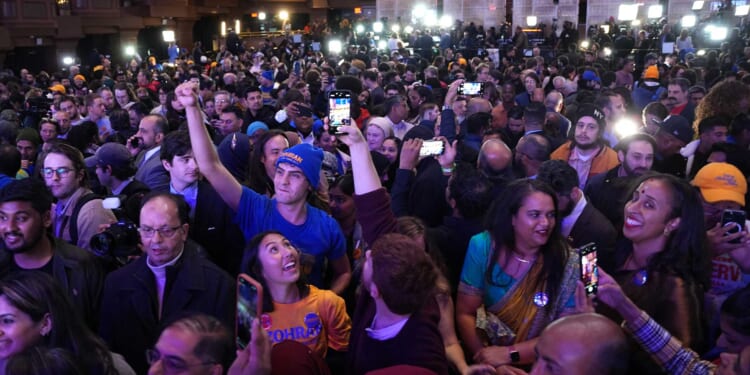
On Tuesday, 34-year-old democratic socialist Zohran Mamdani won New York City’s mayoralty, defeating former governor Andrew Cuomo and Republican Curtis Sliwa by about nine and 43 percentage points, respectively. That outcome, more or less, was expected. Since June’s Democratic primary, polls, including one published by the Manhattan Institute last week, had predicted victory for the Queens assemblyman.
The election held a more surprising result: the racial demographics of Mamdani’s winning coalition resembled President Trump’s from 2024. This was key to his success and the product of a deliberate strategy to engage New York’s ethnic communities on a granular basis.
Finally, a reason to check your email.
Sign up for our free newsletter today.
According to a New York Times analysis, Mamdani won majority-black precincts by 26 percentage points, majority Hispanic by 20 percentage points, and majority Asian by 4 percentage points. This performance marks a significant improvement compared with the primary, in which he won majority-Hispanic precincts by 8 percentage points and actually lost majority-black precincts to Cuomo by 16 percentage points.
Similarly, Trump owed his reelection last year in large part to historic gains among nonwhite Americans. He almost doubled his support among black voters from 8 percent in 2020 to 15 percent in 2024 and effectively matched Kamala Harris among Hispanic voters, losing by only 3 percentage points.
In Gotham specifically, Trump won 30 percent of the vote share—a 7-point increase from 2020 and the best showing for any Republican nominee since George H.W. Bush in 1988. Much of these gains came from areas with a sizeable percentage of blacks and Hispanics, such as the Bronx. In areas where the city’s population is more than 70 percent black or Hispanic, Trump grew his support by 46 percent and 55 percent, respectively.
Even more pronounced were Trump’s and Mamdani’s gains among nonwhite men. In 2024, the president won 21 percent of black male voters and half of Hispanic male voters. By contrast, the mayor-elect drew support from 62 percent of black men and 55 percent of Hispanic men, per exit polls.
Exit polls aren’t always reliable, but in the aftermath of an election they can help shed light on what happened. In the case of the mayoral election, exit polling suggests that voters, including racial minorities, backed Mamdani for the same reason they supported Trump last year: affordability. Indeed, this was the democratic socialist’s central campaign message, and it appeared to resonate. One exit poll found that 55 percent of voters considered cost of living to be the most important issue facing New York City and that 84 percent considered housing costs to be a problem where they live. Another showed that more than two-thirds of voters (64 percent) rated the city’s economy as “not good” or “poor,” while only 17 percent described their family’s financial situation as “getting ahead.”
A Quinnipiac University poll captured this sentiment last month. In it, respondents were given a list of nine issues and asked which was the most important when deciding whom to vote for in New York City’s mayoral election. Affordable housing came in second place (after crime), and inflation came in third. Among voters who identified as Democrats, affordable housing ranked as the top concern; for independents, it was crime, followed by inflation.
The mood nationally has been much the same. An October 3 poll from Pew Research Center found that 74 percent of Americans view economic conditions as just “fair” or “poor,” compared with 26 percent who view them as “excellent” or “good.” What’s more, a little over half (53 percent) said that Trump’s policies have made economic conditions worse, and only 29 percent said they expect things to improve a year from now. This number (29 percent) is down from 36 percent in April and 40 percent in February.
Given both the economic environment in which Americans find themselves, and the fact that many New Yorkers perceived Cuomo as Trump’s puppet (the president’s endorsement of the former governor added to that perception), it’s understandable why Mamdani won.
Yet his victory is due to more than just circumstance—particularly when it comes to nonwhite voters. Mamdani seemed to commit significant time, resources, and energy to mobilizing black, Hispanic, and Asian New Yorkers—groups that often tend to be low-propensity voters.
Mamdani’s refusal to treat these varied nonwhite groups as a monolithic voting bloc is a tactic that both Republicans and Democrats should consider. Broad racial categories flatten important cultural, religious, and linguistic differences among subgroups. Cuban voters differ from Mexican voters, and Indian voters differ from Pakistani voters. These intra-racial distinctions can be politically salient.
Look no further than Mamdani’s engagement of South Asians. He campaigned extensively with Bangladeshis, Pakistanis, and Indian Muslims and Sikhs, yet less so with Indian Hindus, who strongly oppose him. He took a multifaceted approach.
In March, for example, Mamdani spoke at an event of the American Pakistani Advocacy Group for Pakistan Day. Months later, the organization held a rally for him at Makki Masjid, a mosque and Muslim cultural center in an area of Flatbush, Brooklyn, known as Little Pakistan. In the Democratic mayoral primary, Mamdani beat Cuomo by 16 percentage points in Flatbush, and in the general election, by 56 points.
On June 22, Mamdani and Shahana Hanif, a Bangladeshi member of the New York City Council from Kensington, filmed a campaign ad in Bangla. They used Bengali sweets, called mishti, to explain ranked-choice voting. Mamdani defeated Cuomo by 35 percentage points in this Brooklyn neighborhood, home to Little Bangladesh, in the June primary and by 29 points earlier this week. He also won 60 percent of the vote in Jackson Heights and 61 percent of the vote in Parkchester, two more Bangladeshi enclaves.
Throughout his campaign, Mamdani visited the Sikh Cultural Society and Baba Makhan Shah Lubana Sikh Center in South Richmond Hill, a neighborhood nicknamed Little Punjab and home to a large Sikh population. He won the neighborhood by 7 percentage points in the primary and 21 percentage points in the general.
Mamdani engaged other ethnic groups, too. He mobilized specific African diaspora communities and even participated in the city’s Dominican and Puerto Rican pride parades.
Mamdani’s ethnic engagement strategy wasn’t successful across the board. Heavily Chinese and Korean neighborhoods in Queens, for example, went overwhelmingly for Cuomo, despite Mamdani’s best efforts. Jewish voters also rejected the democratic socialist, likely because of his apparent history of anti-Semitism.
Yet, these efforts were good enough to help him win the mayoralty of the greatest city in the world. Mamdani’s potential challengers in 2029 should take note.
Photo by ANGELINA KATSANIS/AFP via Getty Images
Source link


















